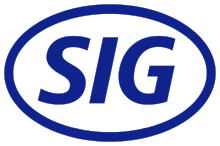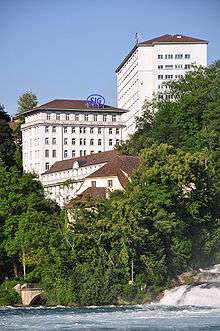Sig Holding AG
 | |
| Subsidiary | |
| Predecessor | SIG Holding AG |
| Founded | 1860 |
| Headquarters | Neuhausen am Rheinfall, Switzerland |
Key people | Graeme Hart |
| Products | Packaging beverage equipment |
| Services | cartons, filling equipment |
| Revenue | 1.721 million EUR (2015) |
Number of employees | ca. 5000 (2015) |
| Parent | ONEX Corporation |
| Divisions | SIG Combibloc, Sig Pack, Sig Beverage |
| Website |
www |



.jpg)
Known by its initials SIG, SIG Holding AG was previously known as Schweizerische Industrie Gesellschaft (German for Swiss Industrial Company, in French as Société Industrielle Suisse, in Italian as Societa Industriale Svizzera ). SIG Holding AG has been active in various businesses during its more than 170 years of operation. Since 2000 the company has undergone strategic refocus, selling the Sig Sauer branches to L&O Holding and its remaining firearms business which became Swissarms.
Today SIG comprises three division: SIG Combibloc which provides aseptic carton packaging and filling machines for liquid products, SIG Pack which provides packaging for food, health, and beauty products, and SIG Beverages which provides turnkey beverage solutions.[1]
On 5 November 2007, SIG Holding AG was acquired by Rank Group NZ, the private investment company of businessman Graeme Hart. Rank announced the sale of SIG Holding AG to ONEX Corporation on 24 November 2014.[2]
History
The origins of the Sig-Sauer company lie in the company named Schweizerische Waggon Fabrik or Swiss Wagon Factory (in English) which was founded in 1853 by Friedrich Peyer im Hof, Heinrich Moser and Johann Conrad Neher.[3][4] In 1860 a state-of-the-art rifle of their creation won a competition by Switzerland's Federal Ministry of Defence, resulting in the award of a contract to produce 30,000 Prelaz-Burnand rifles. The Prélaz-Burnand 1859 was invented by gunsmith Jean-Louis Joseph Prélaz and an army officer Edouard Burnand and adopted as rifle M1863 (15,566 made by SIG).[5]
Firearms
Upon receiving the contract to produce rifles the company name was changed to Schweizerische Industrie Gesellschaft (SIG), German for "Swiss Industrial Company" (in French regions of Switzerland was known as Société Industrielle Suisse).[3] reflecting the new emphasis on their production.[6]
SIG produced other firearms and pioneered the first automatic rifle, The Mondragón Rifle which was produced by SIG between 1908 and ~1910.
The first automatic rifle of the world - Mondragón - was produced by SIG between 1908 and ~1910.[7]
The SIG P210 pistol was developed in 1937 based on the French Model 1935 pistol (The Petter-Browning Design was licensed). It was adopted by the Swiss military in 1949 as the "Pistole 49". The single-action semi-automatic P210 brought SIG much acclaim, due to the precision manufacturing processes employed in its manufacture and its resultant accuracy and reliability. The P210 frame design incorporates external rails that fit closely with the slide, thus eliminating play in the mechanism during firing. The P210 was noted for its extreme accuracy. The Petter-Browning patent which was a refinement of the Browning Hi-Power (P35) which was John Moses Browning's last design which was created for, but not adopted, the French 1935 pistol.[8]
The SIG SG 510/(Stgw.57) battle rifle was produced by SIG from 1957 to 1983. Because of its ventilated barrel jacket, its appearance was vaguely similar to the German MG34 light machine-gun. It used roller-delayed blowback used on the CETME/HK rifles.[9]
The only general purpose machine gun produced by SIG was the SIG 710-3 which is based on the MG42.[10]
In the 1970s SIG purchased both Hammerli[11][12] and J.P. Sauer and Sohn which resulted in the formation of Sig Sauer. Due to Swiss restrictions on the export of military weapons, SIG entered into a relationship with the German company J.P. Sauer & Sohn in order to allow SIG access to the world firearms market.
The P210 was replaced by the Swiss military in 1975 with the P220, dubbed the Pistole 75. This was the first product of a partnership between J.P. Sauer & Sohn. In a 1984 bidding contest to provide more than 300,000 sidearms to the US military, the SIG Sauer P226 was narrowly defeated by the Beretta 92FS who was awarded the contract for the M9 pistol.
In January 1985 SIGARMS was established in Tyson's Corner, Virginia, where the handgun models P220 and P230 were imported into the USA from Sig Sauer in Germany. In 2007 Sigarms changed its name to Sig Sauer.
SIG arms division was purchased in 2000 by L & O Holding.[13] It is now known as Swiss Arms[14]
Railways
In the late 1970s, SIG was the designer and builder of what was at the time Toronto's latest tram (or streetcar), the CLRV L1. Only the first six CLRV cars were made by SIG (out of an order for 10; the rest were cancelled for cost-saving measures). The remaining 190 L2 vehicles, along with 52 articulated variants, were made by Thunder Bay, Ontario-based UTDC (which is now part of Bombardier Transportation).
In the early 1980s, SIG was the designer and builder of the Utrecht sneltram trams. Twenty-seven were ordered and delivered in 1983 and are still running to date[15] (although they are to be replaced in 2017–2018 and 2020).
The tilting system of the SBB RABDe 500 was developed by SIG. The railway branch of SIG was sold in 1995 to Fiat Ferroviaria; today only components are manufactured in the Neuhausen works. SIG also manufactured three passenger coaches for the Trans Europ Express trainset used briefly by Ontario Northland Railway for their Northlander service (two power coaches were made by Werkspoor).[16]
Packaging
The first packaging machines were produced in 1906 on behalf of the Lausanne-based SAPAL company (Société Anonyme des Plieuses Automatiques).
Most of SIG's earlier packaging equipment efforts were focused on small dry food items such as chocolates and candy. With the acquisition of Doboy Packaging in the U.S. on 28 June 1983, SIG grew its international presence. In 1989, through the acquisition of PKL in Linnich, Germany, SIG entered the field of aseptic liquid packaging. This business grew significantly and was later known as SIG Combibloc.
In 2000 SIG concentrated its group focus solely on technology for packaging of food and beverages. By this time many of their traditional businesses such as arms and Rocktools had been divested. Management used the resulting cash to procure global businesses including Krupp Kunstofftechnik (Corpoplast/Blowtec/Kautex brands) and HAMBA in Germany; Ryka Blow Molds in Canada; and a substantial portion of the Italian conglomerate SASIB. The food-related (dry) businesses were organized under the SIG Pack division, while the beverage-related (wet) businesses formed SIG Beverages. Aseptic liquid packaging remained separate under SIG Combibloc.[17]
This strategy, while intended to provide common customer bases with turnkey solutions for entire bottling or packaging lines, never gained enough momentum to be of any durable competitive advantage. Difficulties integrating vastly different businesses and employee cultures resulted in operational execution issues. In particular, high-profile commissioning and installation failures at SIG Beverages in 2003 and 2004 ultimately resulted in erosion of goodwill serious enough to be recorded on financial statements. A refocusing towards primarily aseptics and PET blow-molding resulted in a high number of divestitures and plant closures. The former SASIB wet businesses Simonazzi, Alfa and Meyer/Mojonnier were sold to Tetra Laval in 2005, while HAMBA and Kautex]]/Blowtec went into the hands of separate private investor groups. The food packaging businesses were sold to Robert Bosch Verpackungstechnik in 2004. The former SASIB dry unit Stewart Systems (bread and bun bakery production lines) was sold to UCA Group in 2004 and subsequently merged with AMF Bakery Systems in 2008. Laser guided vehicle manufacturer Elettric 80, part of the 1999 SASIB acquisition, was sold back to its original Italian owners in 2004.
The considerably slimmed-down SIG Beverages unit, focused on machines for PET bottle blow-molding machinery, was sold off to the German concern Salzgitter AG in March 2008. This sale encompassed the subsidiaries Corpoplast, Asbofill, Plasmax and Moldtec.
Today Combibloc is the last remaining business unit of SIG, its sole focus being machinery and materials for aseptic carton packaging.
See also
References
- ↑ http://listofcompanies.co.in/2012/03/11/sig-holding-ag/
- ↑ "reynoldsgroupholdings.com" (PDF). ReynoldsGroupHoldings.com. Retrieved 29 April 2017.
- 1 2 "History - Sig Sauer". SigSauer.com. Retrieved 29 April 2017.
- ↑ http://www.guns-review.com/innovaeditor/assets/SigSauerMCX_516/founders_5.jpg%7CPhoto of Founder
- ↑ "Prelaz-Burnard rifle in Swiss Rifles Forum". Yuku.com. Retrieved 29 April 2017.
- ↑ Sig-Sauer Law Enforcement
- ↑ Firestone, Adam C. "Historic Firearm of the Month, February 2001". Cruffler.com. Retrieved 29 April 2017.
- ↑ "Sig P210". ForgottenWeapons.com. 2 December 2011. Retrieved 29 April 2017.
- ↑ "SIG Stgw 57". ForgottenWeapons.com. 23 September 2011. Retrieved 29 April 2017.
- ↑ "Modern Firearms - SIG MG 710". Guns.ru. Retrieved 29 April 2017.
- ↑ GmbH, CARL WALTHER. "Home - Hämmerli Website". Haemmerli.info. Retrieved 29 April 2017.
- ↑ "SIG-Hammerli Trailside/X-Esse". TonyBrong.Blogspot.com. Retrieved 29 April 2017.
- ↑ Samsel, Aaron (31 May 2013). "SIG SAUER Parent Company Buys GSG, supplier of SIG 1911-22 Handguns". Guns.com. Retrieved 29 April 2017.
- ↑ Kapella, Jürgen. "Swiss Arms: Startseite". SwissArms.ch. Retrieved 29 April 2017.
- ↑ "Zwitserse trams in Utrecht". 29 October 2016. Retrieved 29 April 2017 – via Wikipedia.
- ↑ "The Northlander". UWyo.edu. Retrieved 29 April 2017.
- ↑ http://www.sig.biz/sig-global/en/sig-global/
External links
| Wikimedia Commons has media related to Sig Holding AG. |